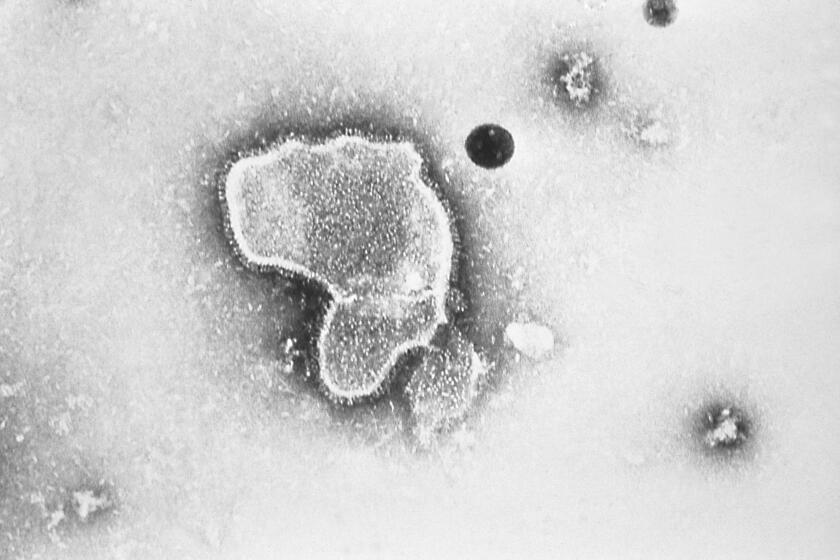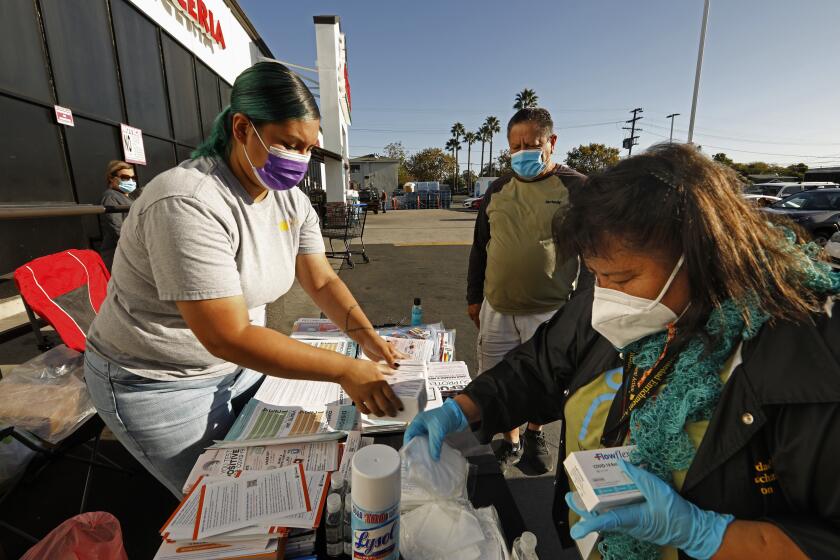Orange County declares health emergency amid spread of RSV

Rapidly spreading viral infections have pushed pediatric hospitalizations and daily emergency room visits to record levels in Orange County, prompting officials to declare a health emergency.
The county, like the rest of California, is facing a viral triple whammy: continued circulation of the coronavirus, seasonal rise of the flu and heightened spread of respiratory syncytial virus, or RSV, a respiratory illness that can be dangerous for small children.
County health officials warned over the weekend that elevated spread of respiratory illnesses, specifically RSV, was severely affecting capacity in the region’s pediatric hospitals.
The illness is highly transmissible, but for otherwise generally healthy adults and older children, it is more of a nuisance than a serious threat. However, babies are particularly vulnerable because the virus attacks the very small airways that lead to their lungs, causing them to become inflamed.
Substantial mucus production can block airways. While adults and older children can simply cough it up, babies may need extra help breathing. Those at highest risk are newborns and infants in their first year of life, especially those under 6 months.
Premature infants, babies with underlying cardiac disease or chronic lung problems, and children with weakened immune systems are at higher risk, too, as are the elderly.
Annually, an estimated 58,000 children under age 5 are hospitalized with RSV nationally, leading to 100 to 500 deaths. Among those 65 and older, an estimated 177,000 are hospitalized a year, with 14,000 deaths.
RSV normally peaks in winter, but cases have increased in October as some California children’s hospitals are becoming overwhelmed.
There’s also worry that the coronavirus — which has been in somewhat of a lull for weeks — could surge again this fall and winter, as has happened each of the past two years.
“While there isn’t a vaccine against RSV, we want O.C. residents to know there are many ways to protect children and at-risk individuals,” Dr. Regina Chinsio-Kwong, Orange County health officer and chief medical officer of the county Health Care Agency, said in a statement Monday night. “Following preventive measures, including remaining up to date with other vaccinations, such as flu and COVID-19, can help reduce the severity of disease and can help reduce the burden on hospitals this fall and winter.”
Chinsio-Kwong also issued a proclamation of local emergency, which would allow access to state and federal resources “to address the situation and seek mutual aid from surrounding counties,” according to the statement.
“Our best shot at protecting ourselves and our children from respiratory illnesses continues to be the same things we practiced throughout the pandemic, including the use of masks when indoors around others and staying home when you are sick,” she said.
County health officials said parents should seek immediate medical attention if their child is having trouble breathing, showing signs of dehydration, has a persistent or high fever or appears very ill. Young children with acute respiratory illnesses also should be kept out of childcare even if they have tested negative for COVID-19.
A new study suggests vaccinating pregnant women protects their newborns from the common but scary respiratory virus called RSV.
RSV is hitting many parts of the nation particularly hard, possibly because transmission has been relatively dormant for the last two years and there are many young children who have little immunity to the virus. Dr. Ashish Jha, the White House’s COVID-19 response coordinator, estimated last week that about 90% of kids end up contracting RSV at least once by the time they’re 2 years old. But “because of the pandemic, some of the kind of standard patterns have been disrupted, so we’re seeing a lot of RSV at once,” he said.
The past two influenza seasons have also been largely mild, which officials attribute in part to the infection-prevention measures implemented in response to the COVID-19 pandemic. However, the vast majority of those measures have been lifted, meaning residents now must make individual determinations regarding whether to wear a face mask or otherwise alter their behavior.
Overall influenza activity in California remains low, but it is increasing, according to the state Department of Public Health. As of mid-October, the flu was most active in the “lower Southern region” — Orange, Riverside, San Bernardino, San Diego and Imperial counties.
The rise of the new coronavirus subvariants is raising concerns of a possible COVID-19 resurgence in fall and winter, as past surges were driven by emerging variants.
Health officials have started sounding the alarm about the triple viral threat California is facing. Heightened simultaneous spread of coronavirus, RSV and influenza, they warn, is a dangerous combination that could further stress healthcare systems in the state.
Officials in Los Angeles County have noted that both RSV and the flu are much more active than typical for this time of year — a development some worry could foreshadow a challenging season.
When 5% of respiratory specimens come back positive for the flu, L.A. County considers that year’s season to be officially underway. The county surpassed that threshold at the start of October. By contrast, the 2018 flu season began in December, and, in 2019, it started in November.
“This is the earliest start to the flu season we’ve experienced in the past five years,” L.A. County Public Health Director Barbara Ferrer said. “We don’t know yet what this means for the trajectory of the flu season this year.”
Recent data show that 23% of children under age 5 who visited emergency rooms in L.A. County in October were there for flu-like illnesses, a percentage that has sharply increased in recent weeks. Among children ages 5 to 11, 17% of ER visits were for flu-like illness.
While the percentages themselves aren’t out of the ordinary — as children in these age groups typically have a higher percentage of emergency room visits blamed on flu-like illness than adolescents or adults — “what is unusual is that we’re seeing such high levels of children in the emergency department reporting influenza-like illness this early in the season,” Ferrer said.
After a pandemic-induced lull, influenza is being detected at increased levels for this time of year in Southern California.
The percentage of respiratory specimens testing positive for RSV in L.A. County is also at its highest level for the last five years. About 12% of specimens are testing positive for RSV, up from around 6% to 7% last October and less than 1% during the prior three Octobers.
Among children younger than 5, 7% of ER visits are related to RSV or acute bronchiolitis, a swelling of the airways that is typically caused by RSV. That’s higher than at any point in the last three years.
“As with the flu, we cannot predict whether this is an early peak or start to a severe season. But we do know that RSV activity is unusually high for this time of year and warrants caution,” Ferrer said.
A “triple whammy of all three viruses circulating at the same time could lead to strains on the already overburdened medical system,” San Diego County health officials wrote in a statement late last week.
“As we see a sharp increase of flu and RSV cases, I am urging San Diegans to do their part to prevent the spread of illnesses,” said county Public Health Officer Dr. Wilma Wooten. “While there’s no vaccine for RSV, ample vaccinations are available for the flu and COVID-19.”
In both cases, Wooten noted that the vaccines “take two weeks to become fully effective, so people should get both shots as soon as possible.”
All the latest on Orange County from Orange County.
Get our free TimesOC newsletter.
You may occasionally receive promotional content from the Daily Pilot.









